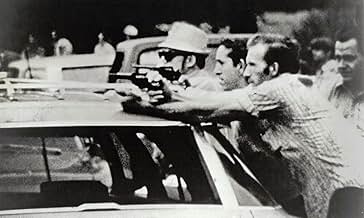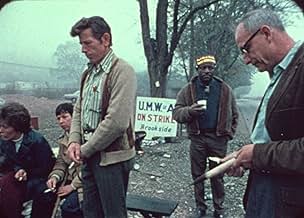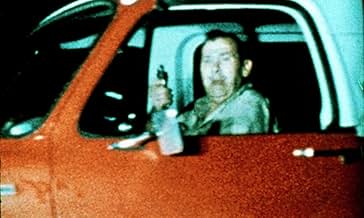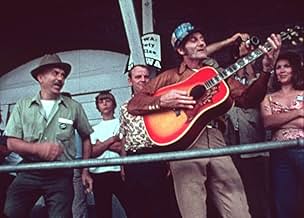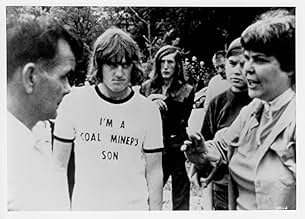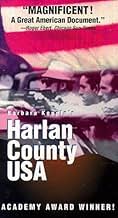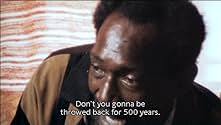Um registro comovente da luta de treze meses entre uma comunidade que luta para sobreviver e uma corporação dedicada aos resultados financeiros.Um registro comovente da luta de treze meses entre uma comunidade que luta para sobreviver e uma corporação dedicada aos resultados financeiros.Um registro comovente da luta de treze meses entre uma comunidade que luta para sobreviver e uma corporação dedicada aos resultados financeiros.
- Ganhou 1 Oscar
- 9 vitórias e 1 indicação no total
- Self - Pres., UMW, 1920-1960
- (cenas de arquivo)
- Self - Black Ling Clinic., W. Va
- (as Dr. Donald Rasmussen)
- Self
- (as Dr. Hawley Wells Jr.)
- Self - Pres., UMW, 1962-1972
- (cenas de arquivo)
- Self
- (cenas de arquivo)
- (as Joseph "Jock" Yablonski)
- Self - Mine Foreman
- (as Basil Collins)
Avaliações em destaque
This is a powerful Oscar-winning documentary produced and directed by Barbara Kopple ('American Dream', 'Wild Man Blues'). It focuses on the men at the Brookside Mine in Harlan, Kentucky who, in the summer of 1973, voted to join the United Mine Workers of America (UMWA). Duke Power Company and its subsidiary, Eastover Mining Company, refused to sign the contract. The miners came out on a long strike, registered by Kopple with testimonies, backstories, archival footage, and music, particularly that of Hazel Dickens during the final credits.
The film's main strength resides in the sincerity of its emotional, political and sociological core without being overtly sentimental, and Kopple's way of testifying instead of exploiting the subjects. The miners and their wives are not depicted in old hillbilly stereotypes, but rather as hard-working human beings fighting for their basic rights ('together we stand, divided we fall').
Thirty years after the release of this documentary, five miners died in an explosion at Harlan County. When the film was shot, money was the bigger issue (industry profits rose 170% in 1975, but miner's wages rose only 4%); nowadays, however, safety is an even bigger issue. You'd think things would have been largely improved since then, but that's not really the case. 'Harlan County U.S.A.' is a remarkable documentary because it testifies and proposes solutions about a public struggle that shouldn't be overlooked, yet has been for such a long time, in the "land of the free and home of the brave".
I can't believe it was so recently that companies were hiring brutal men to terrorize their workers over money.
The movie is set in Harlan County, and there is not much to say but that you are watching history unfold, with all of it's rage and fire, and bloodshed, tears and strength.
Nothing is hidden and it is very powerful. People willing to die for what they believe in, it is very eye opening. The people were real, fearless, and their struggle raw.
There are real villains here, the gun toting hired thugs, and the company who seems OK with the way things are handled. Murdering poor people over a few cents and common sense benefits. Sad.
The most poignant memory of the film for me was how they tricked a truly injured man into coming back to the work site so that they could deny him worker's comp. Quite shocking.
The miners and the picketers are captured via a well-maintained cinema verite style to the point that much of the early dialogue in the film is indiscernible and lingers there only as a means to introduce the tone. Music plays a key role in the emotional impact of this gritty film as well. Considering it takes place in the Bluegrass State, it comes as no surprise that so many of the most intense moments in the film carry with them a heart-wrenching rendition of roots music, most of which pertain specifically to coal mining.
"Harlan County USA" removes the presumptions that such human atrocities are far gone memories of America's past, and would pave the way for other important pro-workers rights films as "Norma Rae", "Silkwood", and "Matewan".
Sure the documentary's one-sided since it shows the vibrant Appalachin coal-mining community struggling in the face of the coal company, strike-breakers, and law-enforcement allies. After all, I guess competing footage would have to be from a company executive session where profits and power are discussed, not indoor plumbing and a living wage. Clearly, the topic sorts itself for the average viewer.
Then there're the faces. You don't get life in the raw like this from a casting call on Hollywood and Vine. The men and women are indelible and a permanent record of the nation's real fabric. True, I don't have much ear for the down-home music that's such a strong narrative part, but I do have a new appreciation for what the artistry stands for. Thanks Barbara Koppel for going where movie-makers seldom go, and recording what many of us seldom see. Sure, that's been 40-years ago, but I dare say the lessons are as topical now as they were then. Maybe more so.
Você sabia?
- CuriosidadesWhen filming began, the film was intended to be about the 1972 campaign by Arnold Miller and Miners For Democracy to unseat UMWA president Tony Boyle, in the aftermath of Joseph Yablonski's murder; however, the Harlan County strike began and caused the filmmakers to change their principal subject, with the campaign and murder becoming secondary subjects.
- Citações
Hawley Wells Jr.: [...] that was when I learned my first real political lesson, about what happens when you take a position against the coal operators, against the capitalists... I found out that the union officials were working with the coal companies. I also found that the Catholic hierarchy was working with the coal companies. Here was a combination of the whole thing, you see: you had to bump against the whole combination of them.
- ConexõesFeatured in Cinéma Vérité: Defining the Moment (1999)
Principais escolhas
- How long is Harlan County U.S.A.?Fornecido pela Alexa
Detalhes
- Data de lançamento
- País de origem
- Central de atendimento oficial
- Idioma
- Também conhecido como
- Harlan County U.S.A.
- Locações de filme
- Empresa de produção
- Consulte mais créditos da empresa na IMDbPro


